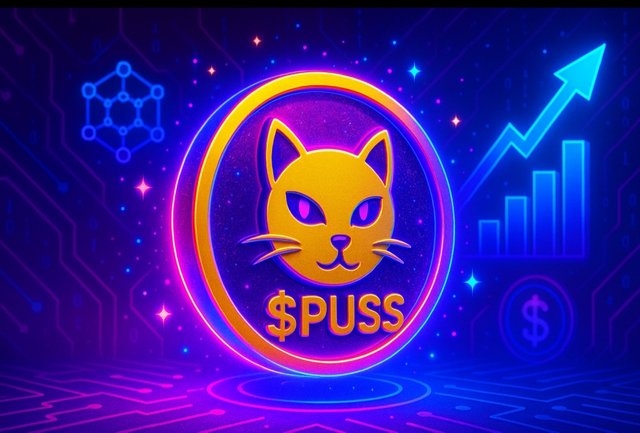The Role Of Cryptoeconomics In $PUSS COIN Consensus
INTRODUCTION
Cryptoeconomics is at the core of security and maintenance for the PUSS Coin Network. Deriving earnings through fees for approving transactions is appropriate for validators and is also one of the mechanisms of dissuading spammers from flooding the network with phony transactions. This market-based approach to transaction prioritization makes the network efficient, demand-responsive, and economically self-regulated, without reliance on centralized enforcement mechanisms.
PUSS Coin governing, in turn, is subject to economic incentives. Token holders gain voting power depending on their stake in the network, hence shaping critical decisions that best serve their interests in accordance with the principle that those most interested in the network on its success should have a direct say into its development. While, if designed properly, it does not allow for centralization, thus remaining a well-defined and open manner of decision-making that benefits all participants and is conducted in the spirit of the greater community.
PUSS Coin is also endowed with a cryptoeconomic mechanism to prevent malicious behavior. According to game theory, reward and punishment influence the rational actor, imposing deterrence on any attempt to break the protocol through double-spending or manipulations. Inflationary and deflationary policies create long-term value by balancing supply and demand. They work together to build a safe, reliable system that's driven by the community.
TRANSACTION FEES MECHANISMS
Transaction fees in the PUSS Coin serve to incentivize the validators economically. Every user ought to set the fees for his/her transactions. Such fees go to the validators for including transactions into blocks. This creates a competition for limited block space and makes sure that the validators get paybacks to economically secure the network.
Another use of the fee mechanism is to deter spams and denial-of-service attacks. It makes sure that users must pay a fee for at least some of their transactions. PUSS Coin simply can't allow endless submission of invalid or very-low-priority transactions because this will drain bandwidth from the network and waste processing resources that should otherwise serve real user activity.
Flexible fees are based on demand. In an increasingly congested network, fees will go up, thus, pressing urgent transactions prior. Under a low demand scenario, fees will be low, which will favor accessibility. This market-driven mechanism allows for balancing load with cost, keeping the PUSS Coin network efficient and at the same time providing continual incentives to validators and miners.
DECENTRALIZED GOVERNANCE AND VOTING POWER
Cryptoeconomics allows token holders in the PUSS Coin ecosystem to participate in governance decisions. Voters are PUSS Coin holders who, depending on the amount of PUSS Coin they stake, may elect on protocol changes, parameter changes, or funding proposals. The number of votes is directly proportional to the economic investment of their holders into the network.
Quadratic voting or capped voting may be implemented in some systems to prevent governance centralization. These systems try to limit the squatters who may have enormous voting power on certain decisions and try to encourage participation at broader levels. PUSS Coin can thus implement its set of cryptoeconomic instruments to guarantee that governance remains decentralized and representative of the vast community.
Decentralized governance also provides legitimacy to the network. The longer users stay feeling in control and heard, the longer they invest themselves in the ecosystem. Through a combination of staking and voting, economic and cryptographic checks combine to make sure PUSS Coin protocol updates are truly decided upon by the collective will, thereby refining trust in the long run.
ATTACK SCENARIOS IN GAME THEORY
In cryptoeconomics, game theory models predict and prevent instances of malicious behavior. Attackers weigh the cost of cheating against potential rewards. PUSS Coin slashing penalties, with its reward loss, cause double-spending or block manipulation to be considered an absurd and irrational money-making activity, thus discouraging harmful behavior from ever taking place.
Validators are assumed to be rational beings. Under cryptoeconomic modeling, honest behavior is made the most profitable option-path, whereas corruption would yield less benefit. By modeling attack scenarios, PUSS Coin intends to engineer consensus design mechanisms that will help reconcile the profit motives of individuals with the overall health of the network.
Attack modeling also safeguards against edge cases. By running simulations for "what if" scenarios like bribery attempts or cartel formation, PUSS Coin is able to develop defensive mechanisms in advance. Game theory does not stop at merely explaining behavior; it also aids engineers in formulating consensus rules that remain solid against adversarial pressure and attempts at practical exploitation.
TOKEN INFLATION AND DEFLATION POLICIES
In PUSS Coin's cryptoeconomic model, there may be a controlled token inflation. This inflationary policy rewards the validators while securing the network. Upon the minting of tokens, either every block or following an epoch, an income channel is created to reward parties engaged in validating transactions and securing consensus.
Yet such inflation needs to be contained so as not to destroy value. In the instance that there is too much inflation, scarceness is diminished, and long-term holders lose confidence in the asset. PUSS Coin can explore other inflation-control measures such as periodically halving, fixed supply caps, and many more, all intended to protect the economic value of the token over time.
Deflationary measures would decrease the supply and increase scarcity, and thus would raise the value of the token, while payouts would discourage spend-term valuations. Inflationary and deflationary mechanisms of PUSS Coin should essentially serve a dual purpose: stability and engagement, and the balance must be maintained between the two.
CONCLUSION
The consensus security and community trust of PUSS Coin depend on crypto economic designs. Through transaction fee incentive models, decentralized governance, game-theoretic security, and carefully calibrated inflation-deflation models, the network aligns individual incentives with collective reliability. The protocol is therefore designed to allow honest behavior by validators, a feeling of being in control among users, and the sustainable change of the protocol from in open and decentralized setting.



https://x.com/Memephiz148421/status/1926139699950690393
https://x.com/Memephiz148421/status/1919432393728901390
https://x.com/Memephiz148421/status/1919430052954923220
https://x.com/Memephiz148421/status/1919429726784930298
https://x.com/Memephiz148421/status/1919429211942453534
Upvoted! Thank you for supporting witness @jswit.
Thank you for sharing on steem! I'm witness fuli, and I've given you a free upvote. If you'd like to support me, please consider voting at https://steemitwallet.com/~witnesses 🌟
@tipu curate 5
Upvoted 👌 (Mana: 1/6) Get profit votes with @tipU :)
Note:-
Regards,
@adeljose